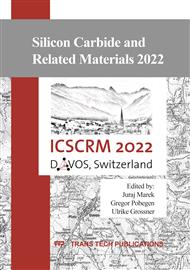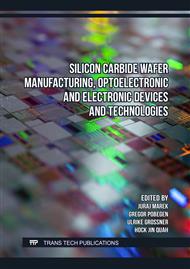[1]
A. El-Shaer, A. Bakin, E. Schlenker, A.C. Mofor, G. Wagner, S.A. Reshanov, A. Waag, Superlattices and Microstructures 42 (2007) 387–391.
DOI: 10.1016/j.spmi.2007.04.078
Google Scholar
[2]
A. Pérez-Tomás, M.R. Jennings, M. Davis, V. Shah, T. Grasby, J.A. Covington, P.A. Mawby, Microelectronics Journal 38 (2007) 1233–1237.
DOI: 10.1016/j.mejo.2007.09.019
Google Scholar
[3]
B.J. Johnson, M.A. Capano, M.A. Mastro, Solid-State Electronics 50 (2006) 1413–1419.
Google Scholar
[4]
V. Domnich, S. Reynaud, R.A. Haber, M. Chhowalla, J. Am. Ceram. Soc. 94 (2011) 3605–3628.
DOI: 10.1111/j.1551-2916.2011.04865.x
Google Scholar
[5]
H. Werheit, J. Phys.: Condens. Matter 18 (2006) 10655–10662.
Google Scholar
[6]
H. Werheit, M. Laux, U. Kuhlmann, R. Telle, Physica Status Solidi B Basic Research 172 (1992) K81–K86.
DOI: 10.1002/pssb.2221720233
Google Scholar
[7]
H. Werheit, Solid State Sciences 86 (2018) 38–44.
Google Scholar
[8]
H. Werheit, H.W. Rotter, S. Shalamberidze, A. Leithe-Jasper, T. Tanaka, Physica Status Solidi (b) 248 (2011) 1275–1279.
DOI: 10.1002/pssb.201046342
Google Scholar
[9]
H. Werheit, A. Leithe-Jasper, T. Tanaka, H.W. Rotter, K.A. Schwetz, Journal of Solid State Chemistry 177 (2004) 575–579.
DOI: 10.1016/j.jssc.2003.04.005
Google Scholar
[10]
T.L. Aselage, D.R. Tallant, J.H. Gieske, S.B. Van Deusen, R.G. Tissot, in: R. Freer (Ed.), The Physics and Chemistry of Carbides, Nitrides and Borides, Springer Netherlands, Dordrecht, 1990, p.97–111.
DOI: 10.1007/978-94-009-2101-6_7
Google Scholar
[11]
J. Mazurowski, S. Lee, G. Ramseyer, P.A. Dowben, MRS Proc. 242 (1992) 637.
Google Scholar
[12]
A.A. Ahmad, N.J. Ianno, P.G. Snyder, D. Welipitiya, D. Byun, P.A. Dowben, Journal of Applied Physics 79 (1996) 8643–8647.
DOI: 10.1063/1.362487
Google Scholar
[13]
J. Berjonneau, G. Chollon, F. Langlais, J. Electrochem. Soc. 153 (2006) C795.
Google Scholar
[14]
A.O. Sezer, J.I. Brand, Materials Science and Engineering: B 79 (2001) 191–202.
Google Scholar
[15]
V. Cholet, R. Herbin, L. Vandenbulcke, Thin Solid Films 188 (1990) 143–155.
DOI: 10.1016/0040-6090(90)90200-w
Google Scholar
[16]
D.N. Kevill, T.J. Rissmann, D. Brewe, C. Wood, Journal of Crystal Growth 74 (1986) 210–216.
DOI: 10.1016/0022-0248(86)90266-6
Google Scholar
[17]
W. Norimatsu, K. Matsuda, T. Terasawa, N. Takata, A. Masumori, K. Ito, K. Oda, T. Ito, A. Endo, R. Funahashi, M. Kusunoki, Nanotechnology 31 (2020) 145711.
DOI: 10.1088/1361-6528/ab62cf
Google Scholar
[18]
G. Ferro, Critical Reviews in Solid State and Materials Sciences 40 (2015) 56–76.
Google Scholar
[19]
T.L. Aselage, R.G. Tissot, Journal of the American Ceramic Society 75 (1992) 2207–2212.
Google Scholar



